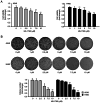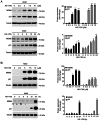HS-1793 inhibits cell proliferation in lung cancer by interfering with the interaction between p53 and MDM2
- PMID: 35928802
- PMCID: PMC9344265
- DOI: 10.3892/ol.2022.13410
HS-1793 inhibits cell proliferation in lung cancer by interfering with the interaction between p53 and MDM2
Abstract
The transcription factor or tumor suppressor protein p53 regulates numerous cellular functions, including cell proliferation, invasion, migration, senescence and apoptosis, in various types of cancer. HS-1793 is an analog of resveratrol, which exhibits anti-cancer effects on various types of cancer, including breast, prostate, colon and renal cancer, and multiple myeloma. However, to the best of our knowledge, the role of HS-1793 in lung cancer remains to be examined. The present study aimed to investigate the anti-cancer effect of HS-1793 on lung cancer and to determine its association with p53. The results revealed that HS-1793 reduced cell proliferation in lung cancer and increased p53 stability, thereby elevating the expression levels of the target genes p21 and mouse double minute 2 homolog (MDM2). When the levels of MDM2, a negative regulator of p53, are increased under normal conditions, MDM2 binds and degrades p53; however, HS-1793 inhibited this binding, confirming that p53 protein stability was increased. In conclusion, the findings of the present study provide new evidence that HS-1793 may inhibit lung cancer proliferation by disrupting the p53-MDM2 interaction.
Keywords: HS-1793; MDM2; anti-cancer; lung cancer; p53.
Copyright: © Lim et al.
Conflict of interest statement
The authors declare that they have no competing interests.
Figures





Similar articles
-
Mir-660 is downregulated in lung cancer patients and its replacement inhibits lung tumorigenesis by targeting MDM2-p53 interaction.Cell Death Dis. 2014 Dec 11;5(12):e1564. doi: 10.1038/cddis.2014.507. Cell Death Dis. 2014. PMID: 25501825 Free PMC article.
-
L-GILZ binds p53 and MDM2 and suppresses tumor growth through p53 activation in human cancer cells.Cell Death Differ. 2015 Jan;22(1):118-30. doi: 10.1038/cdd.2014.129. Epub 2014 Aug 29. Cell Death Differ. 2015. PMID: 25168242 Free PMC article.
-
MicroRNA-340 inhibits prostate cancer cell proliferation and metastasis by targeting the MDM2-p53 pathway.Oncol Rep. 2016 Feb;35(2):887-95. doi: 10.3892/or.2015.4458. Epub 2015 Nov 26. Oncol Rep. 2016. PMID: 26718483
-
Emerging Role of MDM2 as Target for Anti-Cancer Therapy: A Review.Ann Clin Lab Sci. 2016 Dec;46(6):627-634. Ann Clin Lab Sci. 2016. PMID: 27993876 Review.
-
MDM2 oncogene as a novel target for human cancer therapy.Curr Pharm Des. 2000 Mar;6(4):393-416. doi: 10.2174/1381612003400911. Curr Pharm Des. 2000. PMID: 10788589 Review.
Cited by
-
P53/MDM2 Complex-Based Targeted Strategies in Colon Adenocarcinoma.Acta Med Acad. 2023 Apr;52(1):24-29. doi: 10.5644/ama2006-124.398. Acta Med Acad. 2023. PMID: 37326394 Free PMC article.
-
Therapeutic Effect of Resveratrol and its Novel Formulations on Lung Cancer: Focus on Biological Aspects and Underlying Pathways.Curr Med Chem. 2024;31(27):4340-4361. doi: 10.2174/0109298673266259231229050937. Curr Med Chem. 2024. PMID: 38303533 Review.
-
Resveratrol in the Treatment of Gynecological Cancer: Mechanisms and Therapeutic Potential.Curr Med Chem. 2025;32(22):4431-4455. doi: 10.2174/0109298673290941240430171146. Curr Med Chem. 2025. PMID: 38706364 Review.
-
Involvement of AMPKα and MAPK-ERK/-JNK Signals in Docetaxel-Induced Human Tongue Squamous Cell Carcinoma Cell Apoptosis.Int J Mol Sci. 2022 Nov 10;23(22):13857. doi: 10.3390/ijms232213857. Int J Mol Sci. 2022. PMID: 36430348 Free PMC article.
-
Unveiling the potential of HS-1793: a review of its anticancer properties and therapeutic promise.Future Med Chem. 2024;16(21):2301-2311. doi: 10.1080/17568919.2024.2424150. Epub 2024 Nov 18. Future Med Chem. 2024. PMID: 39555577 Review.
References
LinkOut - more resources
Full Text Sources
Research Materials
Miscellaneous
